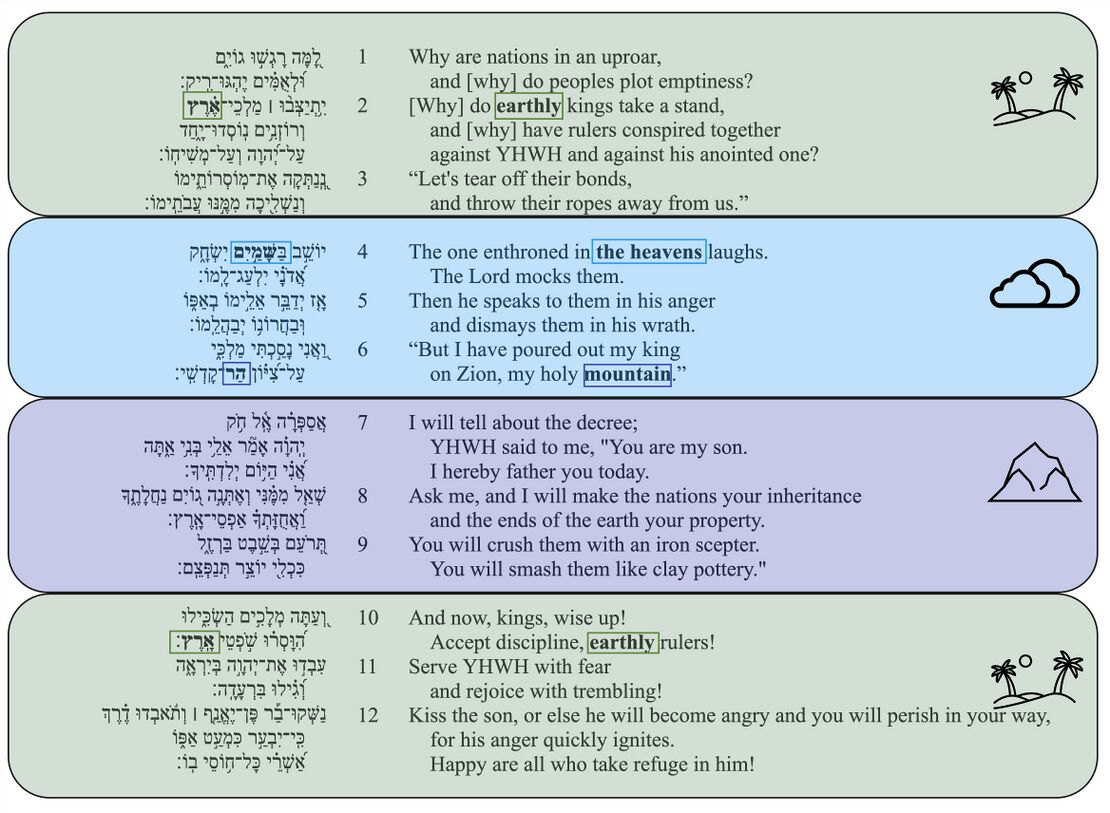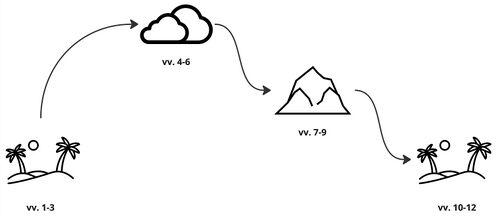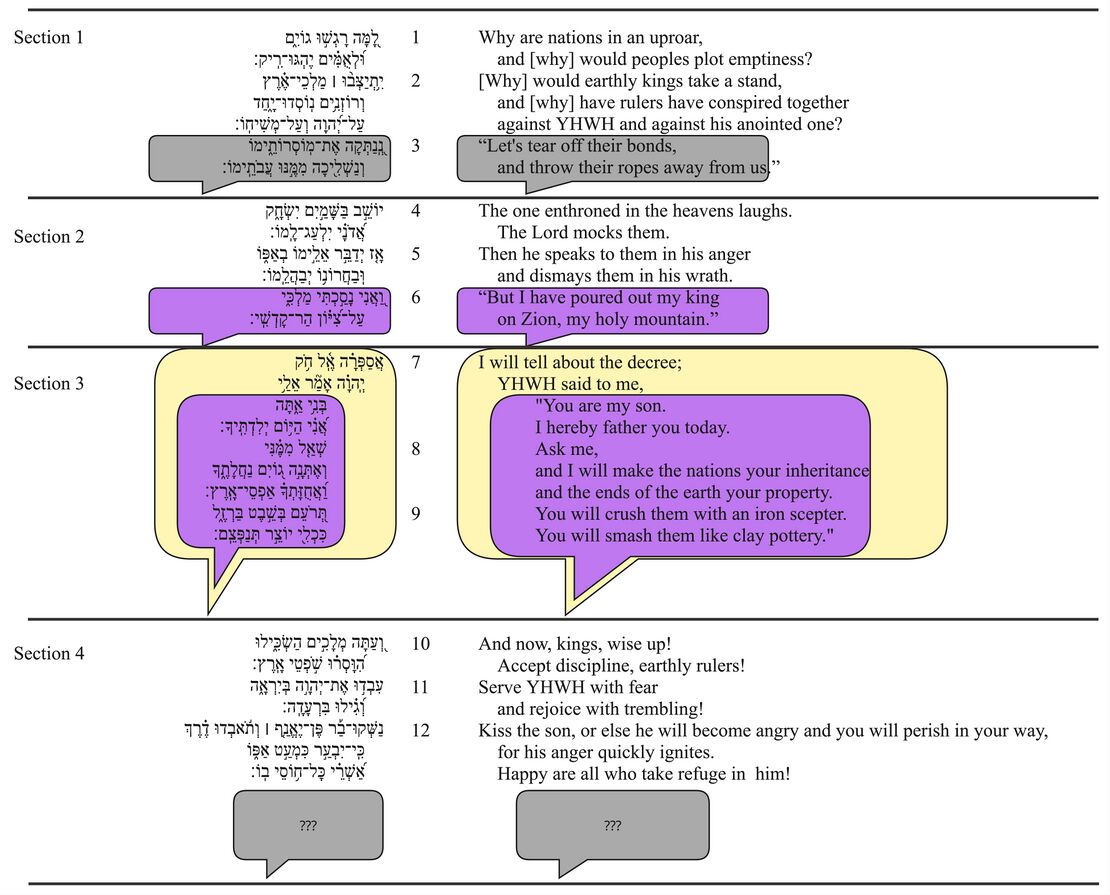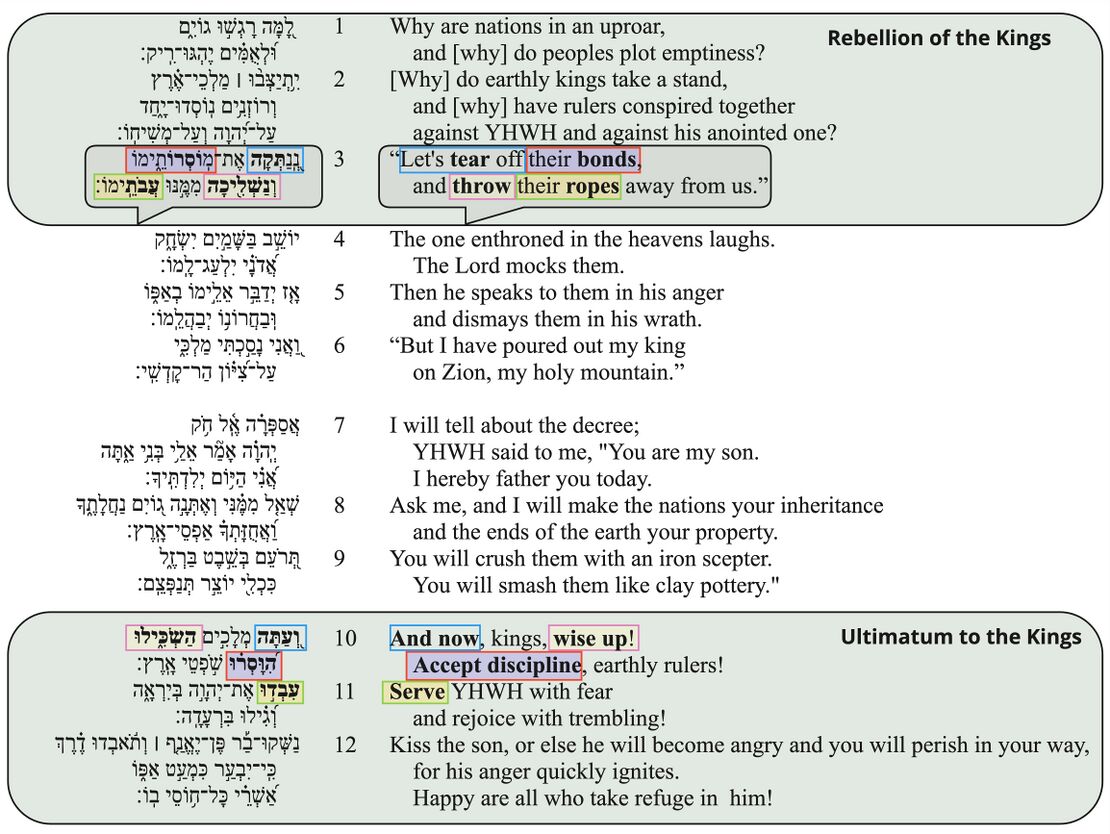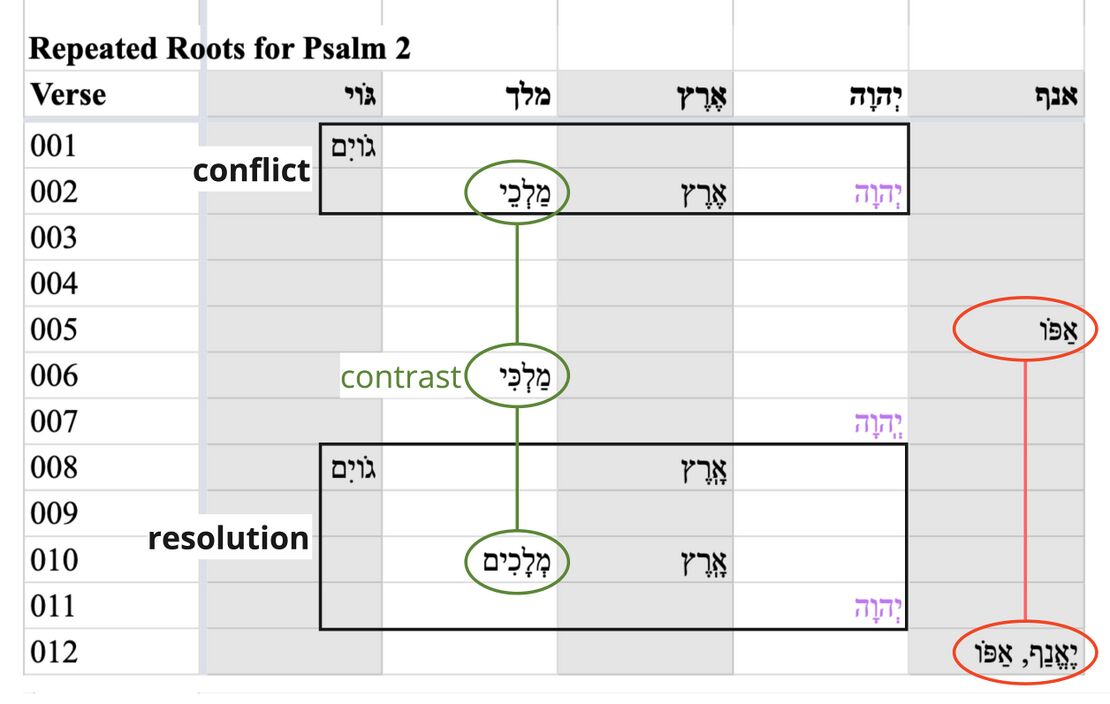Psalm 2 Poetic Features
Poetic Features
In poetic features, we identify and describe the “Top 3 Poetic Features” for each Psalm. Poetic features might include intricate patterns (e.g., chiasms), long range correspondences across the psalm, evocative uses of imagery, sound-plays, allusions to other parts of the Bible, and various other features or combinations of features. For each poetic feature, we describe both the formal aspects of the feature and the poetic effect of the feature. We assume that there is no one-to-one correspondence between a feature’s formal aspects and its effect, and that similar forms might have very different effects depending on their contexts. The effect of a poetic feature is best determined (subjectively) by a thoughtful examination of the feature against the background of the psalm’s overall message and purpose.
Heaven and Earth and In Between
If an emendation or revocalization is preferred, that emendation or revocalization will be marked in the Hebrew text of all the visuals.
| Emendations/Revocalizations legend | |
|---|---|
| *Emended text* | Emended text, text in which the consonants differ from the consonants of the Masoretic text, is indicated by blue asterisks on either side of the emendation. |
| *Revocalized text* | Revocalized text, text in which only the vowels differ from the vowels of the Masoretic text, is indicated by purple asterisks on either side of the revocalization. |
Feature
The first section of the Psalm (vv. 1-3) is about the "kings of earth" (v. 2a). Similarly, the last section of the Psalm (vv. 10-12) is addressed to the "rulers of earth" (v. 10b). The second section (vv. 4-6) is about YHWH, referred to as the "one who rules in the heavens" (v. 4a). The third section (vv. 7-9) is spoken by the king who is on YHWH's "holy mountain" (v. 6b), the meeting place between heaven and earth.
The movement of the Psalm is from earth up to heaven and then downward (heaven --> mountain --> earth).
Effect
The Psalm takes on the character of a cosmic drama. At the beginning of the psalm, the earthly kings are rebelling against the ruler of heaven, and at the end of the psalm they are summoned to submit to God’s king on Zion, and thereby submit to the king of heaven. The center of the drama—and the point where the conflict is resolved—is Mt. Zion, the meeting place between heaven and earth. This is the place where YHWH’s heavenly rule comes to bear on earth, the place where YHWH’s anointed ruler is placed as king.
Dramatic Conversation
If an emendation or revocalization is preferred, that emendation or revocalization will be marked in the Hebrew text of all the visuals.
| Emendations/Revocalizations legend | |
|---|---|
| *Emended text* | Emended text, text in which the consonants differ from the consonants of the Masoretic text, is indicated by blue asterisks on either side of the emendation. |
| *Revocalized text* | Revocalized text, text in which only the vowels differ from the vowels of the Masoretic text, is indicated by purple asterisks on either side of the revocalization. |
Feature
Psalm 2 features multiple speakers. The psalm begins and ends with an anonymous psalmist speaking (see Participant Analysis). In v. 3, the nations speak; in v. 6, YHWH speaks; and in vv. 7-9, the king speaks and quotes YHWH's decree (vv. 7b-9).
The embedded speeches occur at seams in the poetic structure. Each of the first three sections (vv. 1-3; vv. 4-6; vv. 7-9) end with an embedded speech (see Poetic Structure). The only section that does not have direct speech is the final section (vv. 10-12).
Effect
The speeches are part of what make Ps 2 unique compared to other poems in the Psalter. In particular, the speeches give the psalm "a dramatic character."[1] It is as though we are watching a play in which each of the major characters has a speaking part.
The pattern of each section concluding with a speech leads us to expect a speech at the end of the fourth section. Instead, there is no speech, and the fourth section concludes with an ultimatum to the earthly kings. We are left wondering what the nations will say in response. Will they accept the king's dominion and join those who "take refuge in him" (v. 12c), or will they continue their rebellion and perish in their way (v. 12b)?
Think Again
If an emendation or revocalization is preferred, that emendation or revocalization will be marked in the Hebrew text of all the visuals.
| Emendations/Revocalizations legend | |
|---|---|
| *Emended text* | Emended text, text in which the consonants differ from the consonants of the Masoretic text, is indicated by blue asterisks on either side of the emendation. |
| *Revocalized text* | Revocalized text, text in which only the vowels differ from the vowels of the Masoretic text, is indicated by purple asterisks on either side of the revocalization. |
Feature
In the first section of the psalm (vv. 1-3), the psalmist describes the rebellion of the earthly kings, and he presents their rebellious words (v. 3). Then, in the last section of the psalm, he issues an ultimatum to the kings, calling them to reverse their behavior (vv. 10-12).
Several of the words near the beginning of this final section (vv. 10-12) sound similar to the words from the nations' speech in v. 3. In fact, every verb and noun from the nation's speech in v. 3 has some echo in vv. 10-11.
- נַשְׁלִ֖יכָה (v. 3) // הַשְׂכִּ֑ילוּ (v. 10) - similar sounds (sh/s + l + k), also only two hiphil verbs in the psalm
- מֽוֹסְרוֹתֵ֑ימוֹ (v. 3) // הִ֝וָּסְר֗וּ (v. 10) - similar sounds (samek + r + o/u vowel)
- עֲבֹתֵֽימוֹ (v. 3) // עִבְד֣וּ (v. 10) - similar sounds (ayin + bet + dental [t/d])
- נְֽ֭נַתְּקָה (v. 3) // וְ֭עַתָּה (v. 10) - similar sounds (plosive tav, -ah ending. Note also that ע and ק might have sounded similar in biblical Hebrew; for example, ע sometimes had a g sound).
Effect
The address to the earthly kings in vv. 10-12 recycles the same sounds that the kings used in their own speech in v. 3. The echo of this previous rebellious speech underscores the reversal in behavior that the psalmist is calling for in vv. 10ff. He contrasts what they are doing and saying (v. 3) with what they should be doing and saying (vv. 10ff). Instead of "throwing off" the "ropes" of YHWH and his anointed (v. 3b), the kings should "wise up" and "serve" them (vv. 10-11a). Instead of "tearing off" "their bonds" (v. 3a) they should "now... accept discipline" (v. 10). Their original declaration of independence (v. 3) is futile, and they are called to change their defiant posture to one of submission and service.
Repeated Roots
The repeated roots table is intended to identify the roots which are repeated in the psalm.
| Repeated Roots legend | |
|---|---|
| Divine name | The divine name is indicated by bold purple text. |
| Roots bounding a section | Roots bounding a section, appearing in the first and last verse of a section, are indicated by bold red text. |
| Roots occurring primarily in the first section are indicated in a yellow box. | |
| Roots occurring primarily in the third section are indicated in a blue box. | |
| Roots connected across sections are indicated by a vertical gray line connecting the roots. | |
| Section boundaries are indicated by a horizontal black line across the chart. | |
Notes
- Verses 1-2 (boxed in black) present the conflict of the psalm: the "nations" and the "kings" of "earth" are rebelling against "YHWH." Verses 8-11 then describe the resolution of this conflict using some of the same words: the "nations" and the "earth" become the property of YHWH's anointed, and the "kings" and rulers of "earth" serve "YHWH."
- The three-fold repetition of the word "king" (circled in green) highlights a contrast: YHWH's "king" (v. 6) vs the "kings" of earth (vv. 2, 10).
- The repetition of the root אנף ("anger"; circled in red) in v. 5 and v. 12 draws a comparison between YHWH and YHWH's king. Both respond to the nation's rebellion with "anger."
- ↑ Craigie 1983, 65.


